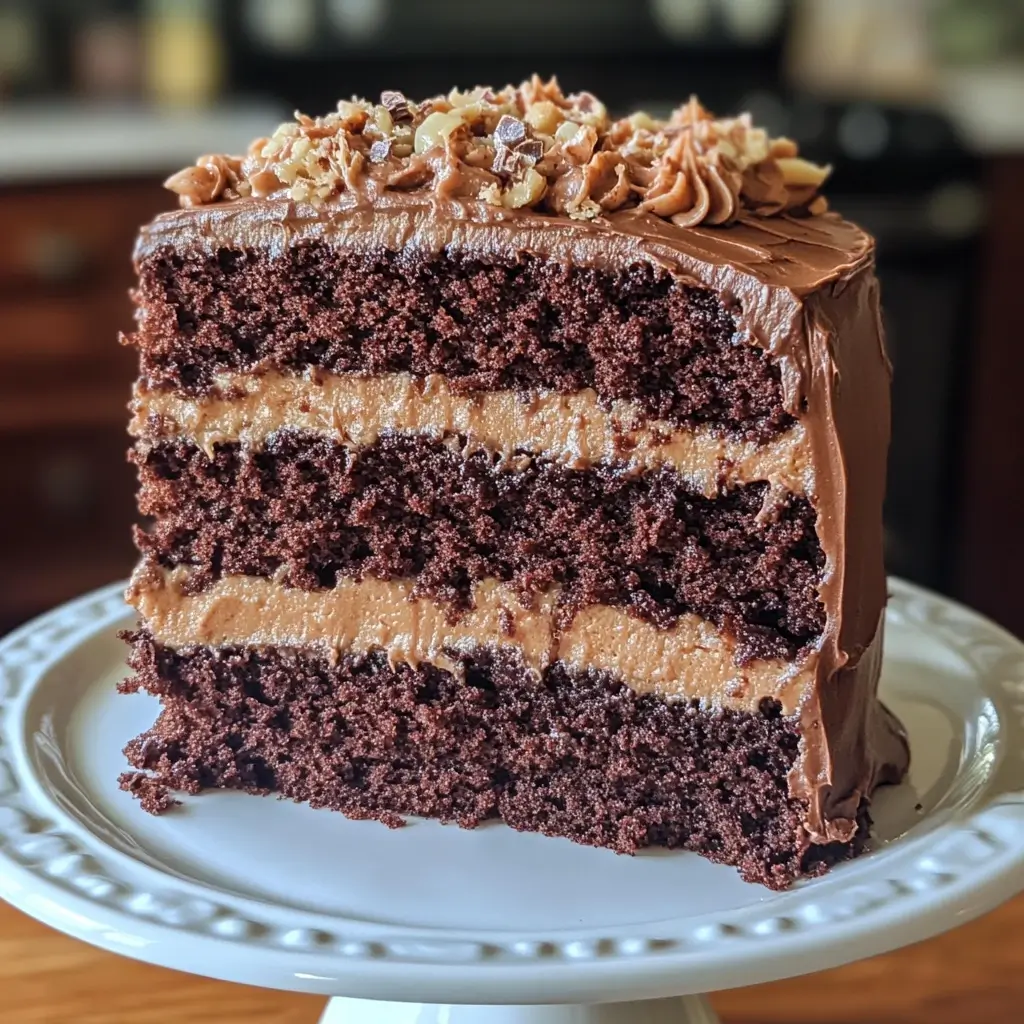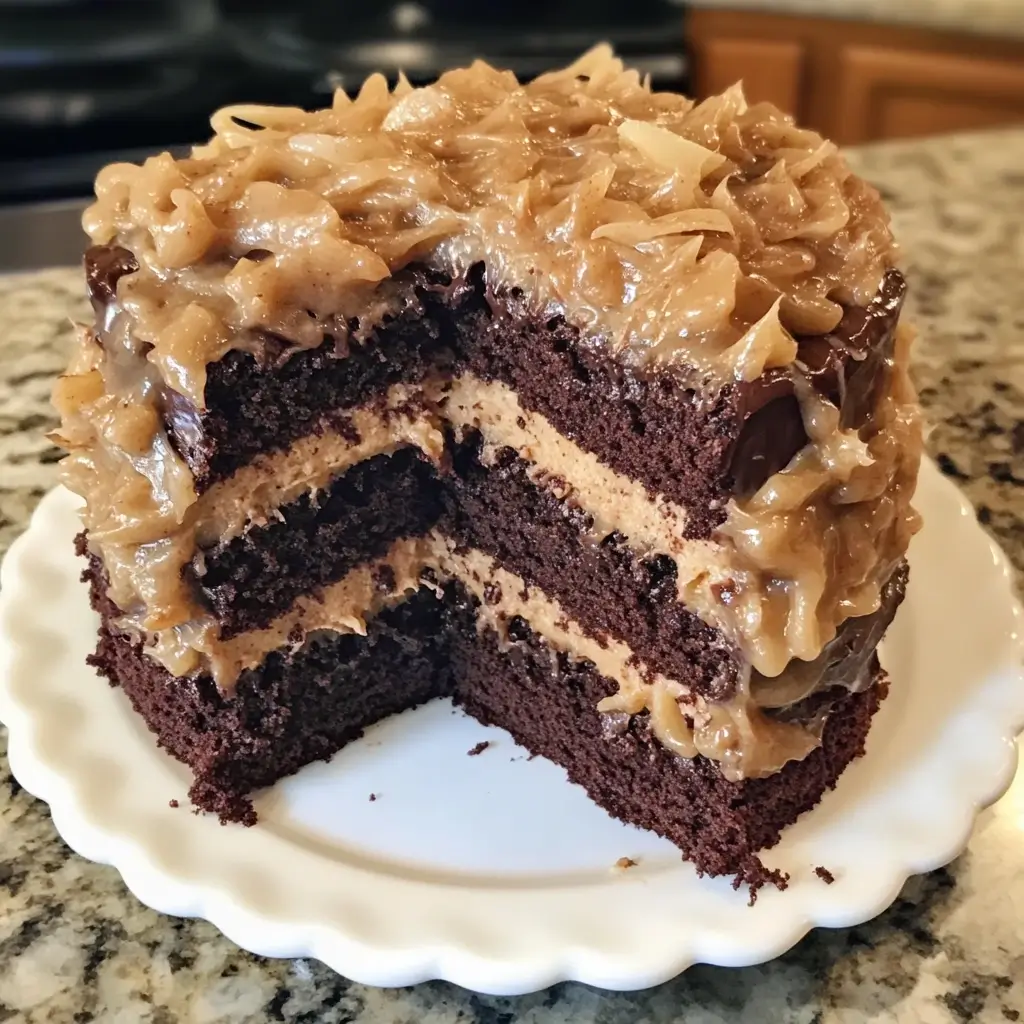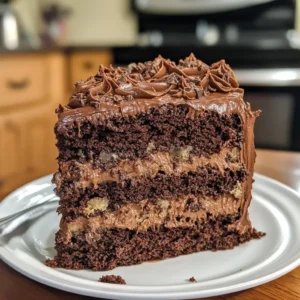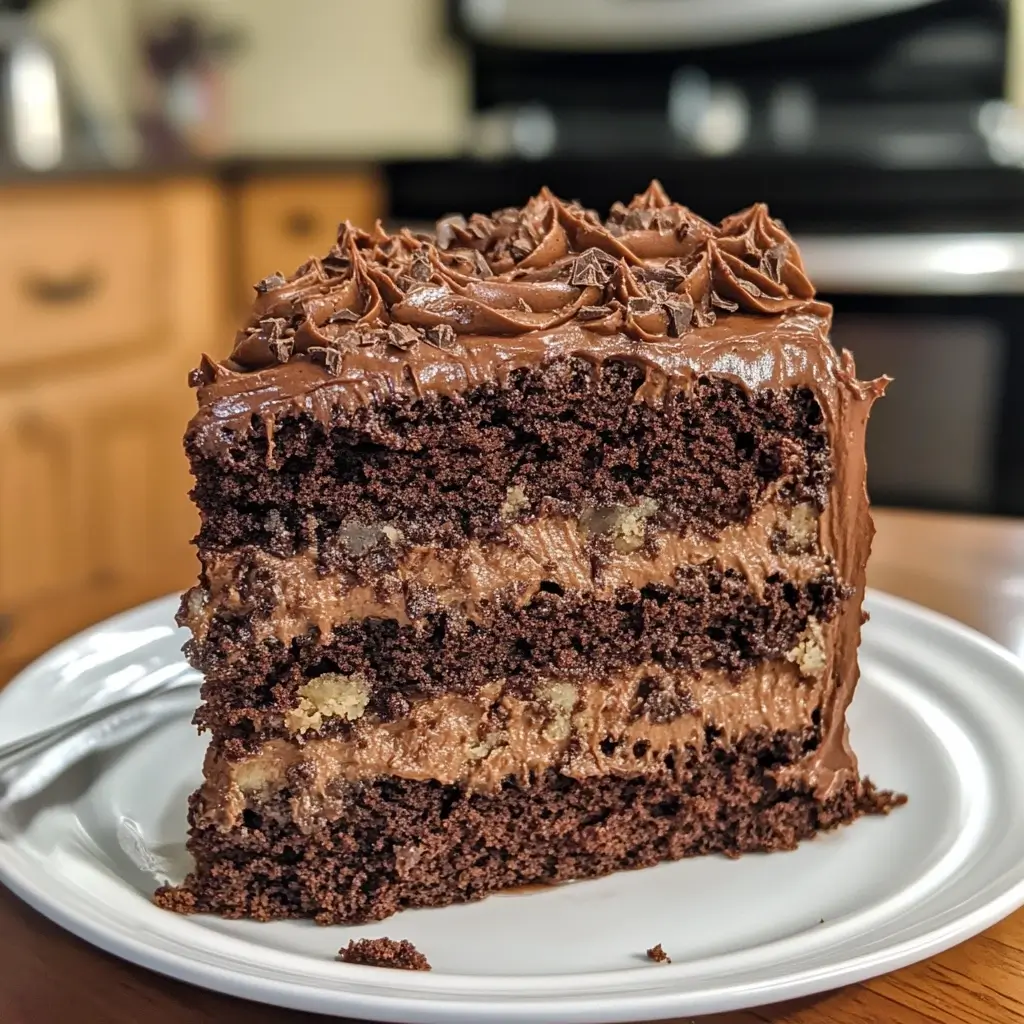German Chocolate Cake is one of America’s most beloved desserts, with its rich chocolate layers, creamy coconut-pecan frosting, and irresistible flavor profile. In this comprehensive guide, we’ll explore everything you need to know about making, enjoying, and innovating with this classic treat. Let’s dive in!
Introduction to German Chocolate Cake
What Makes German Chocolate Cake Unique?
At first glance, German Chocolate Cake might seem like just another chocolate cake. However, what sets it apart is its unique combination of flavors and textures that create a truly unforgettable experience. Unlike many other chocolate cakes that rely solely on ganache or buttercream frostings, German Chocolate Cake features a rich, dense chocolate base topped with a luscious coconut-pecan frosting. This frosting, made with evaporated milk, sugar, eggs, butter, shredded coconut, and toasted pecans, adds an extra layer of indulgence that balances sweetness, nuttiness, and tropical flair.
The cake itself is moist, tender, and deeply chocolatey, thanks to high-quality cocoa powder and buttermilk. These ingredients work together to produce a crumb that’s both soft and flavorful, providing the perfect foundation for the decadent topping. Together, these elements make German Chocolate Cake stand out as a timeless classic that continues to delight bakers and eaters alike.
Common Misconceptions About the Name
One of the most common misconceptions about German Chocolate Cake is that it originates from Germany. Surprisingly, this iconic dessert has no ties to the European country. Instead, it was named after Samuel German, an American chocolatier who developed Baker’s German Sweet Chocolate in 1852. This sweet chocolate variety became the foundation for the recipe when it was first published by Mrs. George Clay in 1957.
The misunderstanding likely arose because people assumed the name referred to the country rather than the person. Over time, the name “German” stuck, leading to confusion among those unfamiliar with its origins. Despite the misconception, the cake remains a quintessential American creation, celebrated for its innovative use of ingredients and bold flavors.
Popularity of German Chocolate Cake
German Chocolate Cake gained national recognition in the late 1950s after the recipe appeared in The Dallas Morning News . The newspaper published a letter from Mrs. George Clay, a Texas homemaker, sharing her delicious creation. The recipe quickly spread across the United States, becoming a staple at birthday parties, weddings, and holiday gatherings. Baker’s Chocolate Company saw an opportunity and began promoting the recipe nationwide, further cementing its place in American baking culture.
Today, May 11th is celebrated as National German Chocolate Cake Day, honoring its enduring legacy. Whether enjoyed as a homemade treat or purchased from bakeries, German Chocolate Cake continues to be a favorite dessert for millions of people around the world.
Key Ingredients for the Perfect German Chocolate Cake

The Importance of High-Quality Cocoa Powder
Using premium cocoa powder is crucial for achieving the deep, rich chocolate flavor that defines German Chocolate Cake. There are two main types of cocoa powder available: Dutch-processed and natural. Dutch-processed cocoa is treated with an alkali to neutralize acidity, resulting in a darker color and smoother flavor. Natural cocoa, on the other hand, retains its natural acidity and has a slightly tangy edge.
Both options work well in German Chocolate Cake, so your choice depends on personal preference. If you prefer a milder, less acidic flavor, opt for Dutch-processed cocoa. For a brighter, more robust chocolate taste, go with natural cocoa. Regardless of which type you choose, always select high-quality brands such as Valrhona, Ghirardelli, or Hershey’s Special Dark to ensure the best possible results.
When measuring cocoa powder, be sure to sift it before adding it to the batter. This removes any lumps and ensures even distribution throughout the cake. Sifting also helps aerate the mixture, contributing to a lighter texture.
Coconut and Pecans – The Signature Topping
The coconut-pecan frosting is what truly sets German Chocolate Cake apart from other chocolate desserts. Shredded coconut brings a light, fluffy texture and tropical aroma, while toasted pecans add crunch and richness. Together, they create a harmonious balance that complements the dark chocolate base perfectly.
To achieve the best flavor and texture, start with unsweetened shredded coconut. Sweetened coconut can overpower the other ingredients, so it’s better to control the sweetness yourself by adjusting the amount of sugar in the frosting. As for the pecans, toasting them enhances their flavor and aroma significantly. To toast pecans, spread them evenly on a baking sheet and bake at 350°F (175°C) for 8–10 minutes until golden brown. Keep an eye on them during the last few minutes to prevent burning.
Once toasted, let the pecans cool completely before chopping them into smaller pieces if desired. This will make it easier to incorporate them into the frosting without breaking them too finely. For added visual appeal, reserve some whole pecan halves to decorate the top of the cake after assembly.
Evaporated Milk – The Secret Ingredient
Evaporated milk plays a critical role in both the cake batter and the frosting. It contributes moisture and creaminess without adding water, which can dilute the flavor. When used in the frosting, evaporated milk creates a silky consistency that holds up beautifully under heat. Its ability to thicken when cooked makes it ideal for creating the signature coconut-pecan topping.
If you don’t have evaporated milk on hand, you can substitute it with a mixture of whole milk and heavy cream. Combine equal parts of each and reduce the mixture by simmering it gently on the stove until it reaches the desired thickness. While this substitution works in a pinch, keep in mind that the flavor and texture may not be exactly the same as using evaporated milk.
In addition to its use in the frosting, evaporated milk can also be incorporated into the cake batter for added moisture. Simply replace part of the liquid called for in the recipe with evaporated milk, adjusting the quantity based on the specific instructions provided.
Other Essential Ingredients
While cocoa powder, coconut, pecans, and evaporated milk are the stars of German Chocolate Cake, several other ingredients play vital roles in ensuring success:
- Buttermilk : Provides acidity and tenderness, resulting in a soft crumb. If you don’t have buttermilk, you can make a DIY version by mixing 1 cup of milk with 1 tablespoon of white vinegar or lemon juice. Let the mixture sit for 5–10 minutes before using.
- Eggs : Add structure and richness to the cake. Use large eggs unless otherwise specified in the recipe, and allow them to come to room temperature before incorporating them into the batter.
- Vanilla Extract : Enhances the overall flavor profile, tying all the ingredients together. Always use pure vanilla extract instead of imitation vanilla for superior taste.
- Baking Soda and Baking Powder : Act as leavening agents to help the cake rise properly. Be sure to measure these ingredients carefully, as too much or too little can affect the final result.
By paying attention to these details, you’ll be well on your way to creating a German Chocolate Cake that rivals those found in professional bakeries.
If you’re looking for an exceptional German Chocolate Cake recipe to try at home, the Willard Family German Chocolate Cake from AllRecipes is a highly-rated option that combines rich chocolate layers with a luscious coconut-pecan frosting. This family-favorite recipe has been perfected over generations and promises delicious results every time.
Step-by-Step Guide to Making German Chocolate Cake

Preparing the Cake Batter
The key to a successful German Chocolate Cake lies in proper preparation of the batter. Start by sifting the dry ingredients—flour, cocoa powder, baking soda, and salt—to remove lumps and aerate the mixture. This step ensures even distribution of the ingredients and prevents pockets of flour or cocoa from forming in the finished cake.
In another bowl, whisk together the wet ingredients: buttermilk, oil, vanilla extract, and eggs. Gradually combine the two mixtures, alternating between the dry ingredients and buttermilk until smooth. Begin and end with the dry ingredients to minimize gluten development, which can lead to a dense cake.
Avoid overmixing the batter, as this can cause the cake to become tough. Mix just until the ingredients are fully incorporated, then divide the batter evenly into greased and floured cake pans. Tap the pans gently on the counter to release any air bubbles before placing them in the oven.
Baking the Cake Layers
Preheat your oven to 350°F (175°C). For standard 8-inch or 9-inch round pans, bake the cake layers for 25–30 minutes, or until a toothpick inserted into the center comes out clean. Rotate the pans halfway through baking to ensure even cooking.
Let the cakes cool in the pans for 10 minutes before transferring them to a wire rack. Allow them to cool completely before assembling the cake. Cooling the layers thoroughly is essential to prevent the frosting from melting when applied.
Making the Coconut-Pecan Frosting
To prepare the frosting, combine evaporated milk, sugar, butter, and egg yolks in a saucepan over medium heat. Stir constantly until the mixture thickens and coats the back of a spoon. Remove from heat and stir in vanilla extract, shredded coconut, and toasted pecans. Let the frosting cool slightly before spreading it onto the cake.
For best results, cook the frosting slowly and patiently. Rushing the process can cause the mixture to curdle or separate. Once removed from the heat, continue stirring occasionally as it cools to prevent a skin from forming on the surface.
Assembling the Cake
Once the cake layers and frosting are ready, use a serrated knife to level the tops if necessary. Place one layer on a serving plate, spread a generous amount of frosting on top, then stack the second layer. Finish by frosting the sides and top of the cake, ensuring an even coating.
To create a polished appearance, use an offset spatula or bench scraper to smooth the frosting. Reserve some whole pecan halves to decorate the top of the cake, arranging them in a decorative pattern if desired. Chill the assembled cake in the refrigerator for at least 30 minutes before slicing and serving to allow the frosting to set properly.
Variations and Twists on Traditional German Chocolate Cake

Gluten-Free German Chocolate Cake
For those following a gluten-free diet, substituting all-purpose flour with a gluten-free blend works wonders. Look for blends containing xanthan gum, which helps maintain the cake’s structure. If the blend doesn’t already include xanthan gum, add 1/2 teaspoon per cup of flour to compensate.
You might also need to increase the liquid content slightly to compensate for the lack of gluten. Start by adding an extra tablespoon of buttermilk or evaporated milk and adjust as needed during testing. Additionally, consider using almond flour or coconut flour for added richness and moisture.
Vegan German Chocolate Cake
Creating a vegan version of German Chocolate Cake involves replacing eggs with flaxseed or chia seed “eggs” and swapping dairy products with plant-based alternatives like almond milk or coconut cream. To make a flaxseed egg, mix 1 tablespoon of ground flaxseed with 3 tablespoons of water and let it sit for 5–10 minutes until gelatinous.
Use vegan butter or margarine for the frosting, and consider using shredded unsweetened coconut to keep it dairy-free. For the pecans, ensure they’re sourced from a facility that doesn’t process tree nuts alongside peanuts if allergies are a concern.
Mini German Chocolate Cupcakes
Transform the classic cake into bite-sized delights by filling cupcake liners with the batter and baking for 18–20 minutes. Top each cupcake with a dollop of coconut-pecan frosting for a party-ready treat. These mini versions are perfect for serving at large gatherings or as individual servings.
To enhance presentation, pipe the frosting onto the cupcakes using a star tip for a professional look. Garnish with additional toasted pecans or a sprinkle of shredded coconut for added texture and visual appeal.
Adding Modern Flavors
Experiment with modern twists, such as adding salted caramel drizzle for a salty-sweet contrast or soaking the pecans in bourbon or whiskey for added depth. These updates bring a contemporary spin to a timeless favorite.
Other ideas include incorporating espresso powder into the cake batter for a mocha twist, adding a layer of chocolate ganache between the cake layers, or substituting macadamia nuts for pecans to change up the flavor profile. The possibilities are endless, allowing you to personalize the cake to suit your tastes.
Fun Facts and Serving Suggestions
Interesting Facts About German Chocolate Cake
Did you know that Mrs. George Clay’s original recipe appeared in The Dallas Morning News in 1957? Her innovative use of Baker’s German Sweet Chocolate catapulted the dessert into fame, inspiring countless home bakers nationwide. Within weeks of publication, Baker’s Chocolate Company reported a 400% increase in sales of their product, demonstrating the recipe’s widespread appeal.
Another fun fact: despite its popularity, German Chocolate Cake isn’t typically found in Germany. Its unique combination of flavors makes it a uniquely American creation. Interestingly, the recipe didn’t gain traction outside the U.S. until much later, proving that some culinary traditions remain region-specific.
Best Pairings for German Chocolate Cake
This rich cake pairs beautifully with beverages like coffee, espresso, or tea. The bitterness of coffee complements the sweetness of the cake, while the warmth of tea provides a soothing contrast. For a decadent pairing, serve it alongside a scoop of vanilla ice cream or whipped cream. The cool, creamy textures enhance the warm, gooey frosting.
If you’re hosting a dinner party, consider pairing German Chocolate Cake with a glass of red wine, such as Cabernet Sauvignon or Merlot. The tannins in the wine balance the sweetness of the cake, creating a sophisticated dessert course.
Storing and Freezing Tips
Store leftover cake at room temperature in an airtight container for up to three days. If freezing, wrap individual layers tightly in plastic wrap and aluminum foil. Thaw overnight in the refrigerator for best results.
For long-term storage, consider freezing the entire assembled cake. Wrap it securely in multiple layers of plastic wrap and foil, then place it in a freezer-safe container. When ready to serve, thaw the cake in the refrigerator for several hours or overnight, allowing the frosting to soften gradually.

German Chocolate Cake
Equipment
- Mixing bowls (large and medium)
- Whisk or electric mixer
- 9-inch round cake pans (2 or 3, depending on desired height)
- Parchment paper
- Spatula
- Saucepan (for making frosting)
- Cooling rack
- Knife or offset spatula (for frosting)
Ingredients
- For the Cake:
- 4 ounces unsweetened chocolate finely chopped
- 1/2 cup boiling water
- 2 1/2 cups all-purpose flour
- 1 teaspoon baking soda
- 1/2 teaspoon salt
- 1 cup unsalted butter softened
- 2 cups granulated sugar
- 4 large eggs separated into yolks and whites
- 1 teaspoon vanilla extract
- 1 cup buttermilk or substitute with milk + 1 tablespoon vinegar
- For the Coconut-Pecan Frosting:
- 1 cup evaporated milk
- 1 cup granulated sugar
- 1/2 cup unsalted butter
- 3 large egg yolks
- 1 teaspoon vanilla extract
- 1 1/3 cups sweetened shredded coconut
- 1 cup chopped pecans
Instructions
- Preheat the Oven : Preheat your oven to 350°F (175°C). Grease and flour two or three 9-inch round cake pans, and line the bottoms with parchment paper.
- Melt the Chocolate : Place the chopped unsweetened chocolate in a heatproof bowl. Pour the boiling water over the chocolate and stir until smooth. Let cool slightly.
- Prepare the Dry Ingredients : In a medium bowl, whisk together the flour, baking soda, and salt.
- Make the Cake Batter :
- In a large mixing bowl, cream the softened butter and sugar together until light and fluffy.
- Beat in the egg yolks one at a time, followed by the vanilla extract.
- Gradually add the melted chocolate mixture, alternating with the buttermilk, and mix until smooth.
- Stir in the dry ingredients until just combined.
- In a separate bowl, beat the egg whites with a whisk or electric mixer until stiff peaks form. Gently fold the beaten egg whites into the batter in three parts, being careful not to deflate the mixture.
- Bake the Cake : Divide the batter evenly among the prepared cake pans. Bake for 25–30 minutes (for two pans) or 20–25 minutes (for three pans), or until a toothpick inserted into the center comes out clean. Let the cakes cool in the pans for 10 minutes, then transfer them to a cooling rack to cool completely.
- Make the Coconut-Pecan Frosting :
- In a saucepan over medium heat, combine the evaporated milk, sugar, butter, and egg yolks. Cook, stirring constantly, until the mixture thickens (about 10–12 minutes).
- Remove from heat and stir in the vanilla extract, shredded coconut, and chopped pecans. Let the frosting cool to room temperature before using.
- Assemble the Cake :
- Place one cake layer on a serving plate. Spread a generous layer of the coconut-pecan frosting evenly over the top.
- Add the second layer and repeat with the frosting. If using a third layer, repeat the process.
- Frost the sides of the cake with the remaining frosting, using a spatula to create an even layer.
- Serve : Slice the cake into wedges and serve at room temperature.
Notes
If you don’t have buttermilk, make a substitute by adding 1 tablespoon of vinegar or lemon juice to 1 cup of milk and letting it sit for 5 minutes.
The coconut-pecan frosting can be made ahead and stored in the refrigerator for up to 3 days. Reheat gently before using.
Store leftovers in an airtight container at room temperature for up to 2 days or in the refrigerator for up to 5 days.

